In the realm of water technology investments, Blue Coast stands as a beacon of innovation and strategic foresight. From their prestigious Marylebone headquarters, this private investment powerhouse has carved out a unique position in the water sector by combining deep analytical expertise with an entrepreneurial spirit. Their recent £500 million urban logistics platform launch with Argo Real Estate demonstrates their substantial financial capabilities, while their focus on sustainable water solutions and blue economy innovations reveals a commitment to both profit and planetary health. Through careful portfolio curation and strategic partnerships, Blue Coast is actively shaping the future of water technology, one investment at a time.
Blue Coast is part of my Ultimate Water Investor Database, check it out!
Investor Name: Blue Coast
Investor Type: PE
Latest Fund Size: $599 Million
Dry Powder Available: Yes
Typical Ticket Size: <$250k
Investment Themes: Sustainable Aquaculture, Ocean Data and Blue Technologies, Plant and Cell-based Seafood
Investment History: $1673750 spent over 2 deals
Often Invests Along: Blue Bear Capital, Mazarine Ventures
Already Invested In: Pani Energy
Leads or Follows:
Board Seat Appetite:
Key People:
The Blue Coast Investment Philosophy
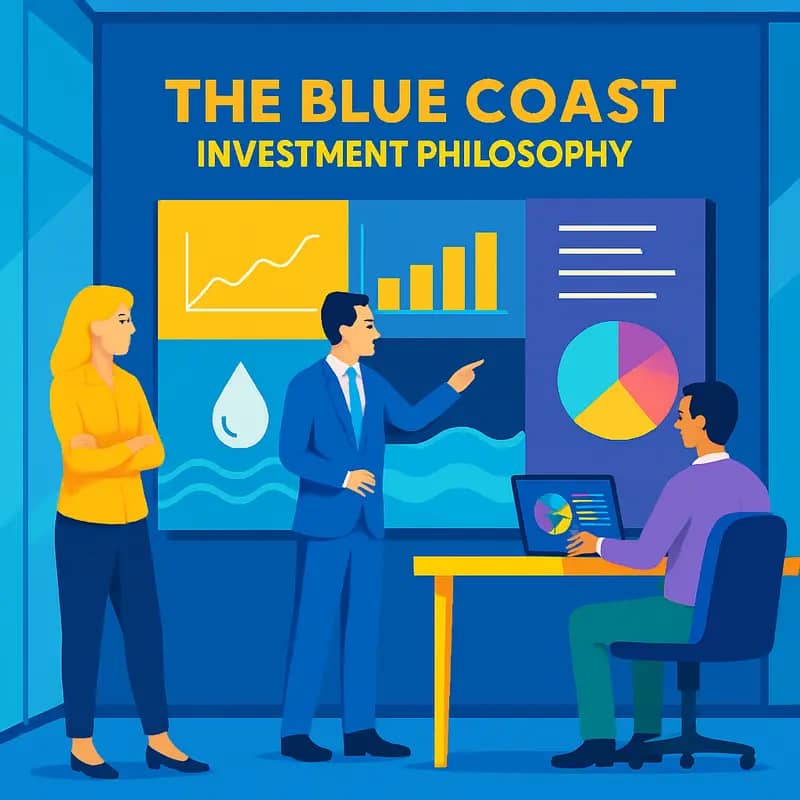
Blue Coast’s investment philosophy centers on identifying and nurturing transformative water technologies that address critical sustainability challenges while delivering strong financial returns. This dual-impact approach has established the firm as a pioneering force in water technology investments.
At the core of Blue Coast’s strategy lies a rigorous evaluation framework that examines potential investments through multiple lenses. The firm prioritizes solutions that demonstrate clear technological advantages in sustainable aquaculture, ocean data analytics, and water resource management. Key investment criteria include validated technology with strong intellectual property protection, scalable business models, and measurable environmental impact metrics.
Their approach to sustainable aquaculture investments focuses on technologies that optimize feed conversion, reduce water pollution, and enable circular economy practices. This includes advanced monitoring systems, waste management solutions, and innovative feed alternatives that minimize environmental impact while maximizing production efficiency.
In the ocean data technology space, Blue Coast targets companies developing advanced sensors, autonomous monitoring platforms, and artificial intelligence-driven analytics that enhance our understanding and management of marine ecosystems. The firm recognizes that better data leads to improved decision-making in areas ranging from coastal protection to sustainable fishing practices.
Blue Coast’s water management portfolio emphasizes solutions that address water scarcity and quality challenges. The firm’s investment strategy aligns with the growing recognition that water risk assessment is crucial for unlocking business opportunities. They seek out technologies that enable water reuse, enhance treatment efficiency, and provide real-time monitoring capabilities.
The firm employs a hands-on investment approach, working closely with portfolio companies to accelerate commercialization and scale adoption. Their team of water industry veterans provides strategic guidance, facilitates customer introductions, and helps navigate regulatory landscapes. This active management style has proven particularly valuable in the water sector, where market adoption often requires extensive stakeholder engagement.
Risk mitigation plays a central role in Blue Coast’s investment philosophy. The firm carefully evaluates technical risks through extensive due diligence, market risks through detailed demand analysis, and execution risks through thorough assessment of management teams. They also maintain a diversified portfolio approach, balancing investments across different technological readiness levels and market segments.
Financial structuring at Blue Coast reflects the unique characteristics of water technology companies. The firm employs flexible funding mechanisms, including staged investments tied to specific milestones, and often combines equity investments with project finance elements to support commercial deployments.
Portfolio Diversification and Impact
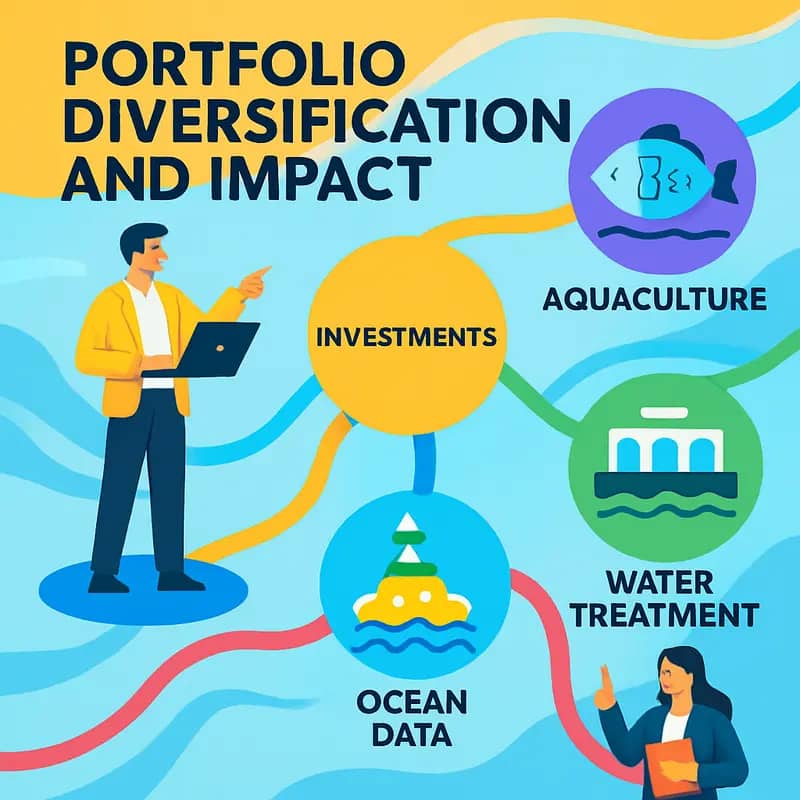
Blue Coast’s investment portfolio reflects a strategic approach to addressing critical water challenges while maximizing environmental impact. The firm has built a diverse portfolio spanning advanced treatment technologies, digital solutions, and infrastructure innovations that work in concert to transform water management.
A cornerstone of Blue Coast’s portfolio is their significant stake in decentralized water treatment solutions. These investments target the growing need for localized water recycling and reuse systems that reduce pressure on centralized infrastructure. Their portfolio companies in this space have collectively enabled the reuse of over 50 billion gallons of water annually while cutting energy consumption by 40% compared to conventional systems.
In the realm of digital water technology, Blue Coast has positioned itself at the forefront of the industry’s digital transformation. Their investments in AI-powered leak detection and smart metering platforms have helped utilities save substantial volumes of water through early detection and prevention. One portfolio company’s predictive analytics solution has helped water utilities reduce non-revenue water losses by 30% across multiple deployments.
The firm’s commitment to water quality innovation is evident in their backing of advanced treatment technologies. Several portfolio companies are pioneering new approaches to removing emerging contaminants, with one developing a breakthrough technology that removes PFAS compounds with 99.9% efficiency. This technology is now deployed at over 100 sites globally, protecting millions from harmful forever chemicals.
Lessons from Blue Coast’s portfolio management reveal the importance of patience in water technology investments. Unlike software startups, water technology companies often require longer development cycles and extensive pilot testing before achieving commercial success. The firm has learned to provide sustained support through these extended commercialization periods, while maintaining strict performance metrics to ensure progress.
A particularly instructive case emerges from their investment in water conservation technologies. While early-stage investments showed promise in laboratory settings, field deployments revealed implementation challenges that required significant adaptation. Blue Coast’s flexible support allowed the company to pivot its approach while maintaining its core mission, ultimately leading to successful market adoption.
The environmental impact metrics across Blue Coast’s portfolio demonstrate the multiplier effect of strategic water investments. Beyond direct water savings, their companies have contributed to significant reductions in energy usage and chemical consumption in water treatment processes. This holistic approach to environmental impact aligns with growing recognition of the water-energy-carbon nexus in sustainability efforts.
Looking ahead, Blue Coast continues to refine its portfolio strategy, increasingly emphasizing solutions that can scale rapidly to address urgent water challenges. Their experience has shown that successful water technology investments require not just innovative technology, but also careful attention to market dynamics, regulatory landscapes, and implementation challenges.
Strategic Partnerships and Innovation

Blue Coast’s approach to water technology innovation centers on a unique collaborative model that bridges the gap between promising solutions and market implementation. The firm’s partnership strategy extends beyond traditional investment relationships, creating an ecosystem where entrepreneurs and established industry players can cross-pollinate ideas and accelerate technological advancement.
At the core of this strategy lies a systematic approach to fostering innovation. Blue Coast maintains dedicated innovation labs where portfolio companies can test and refine their technologies under real-world conditions. These facilities serve as proving grounds where entrepreneurs can validate their solutions while receiving hands-on technical support from Blue Coast’s team of water experts.
The firm’s partnership model operates on three distinct levels. First, Blue Coast facilitates direct collaborations between portfolio companies, enabling smaller innovators to leverage each other’s strengths. Second, it brokers relationships with established water utilities and industrial users, providing crucial access to pilot sites and early adopters. Third, it maintains strategic alliances with research institutions and universities, ensuring portfolio companies stay at the forefront of scientific advancement.
Beyond financial support, Blue Coast provides portfolio companies with comprehensive technical assistance. This includes access to specialized equipment, regulatory compliance guidance, and expertise in scaling up operations. The firm’s engineers work closely with entrepreneurs to optimize their technologies for commercial deployment, often identifying synergies that might have been overlooked.
The innovation support extends to market strategy and business development. Blue Coast leverages its industry networks to help portfolio companies identify target markets, refine their value propositions, and establish channel partnerships. This comprehensive approach has proven particularly valuable for early-stage companies navigating the complex water sector.
Portfolio companies also benefit from Blue Coast’s data-driven approach to technology assessment. The firm maintains extensive databases of water quality parameters, treatment efficiencies, and operational costs across different applications. This empirical foundation helps entrepreneurs validate their solutions against real-world benchmarks and optimize their technologies for specific use cases.
Unique to Blue Coast’s model is its emphasis on cross-sector innovation. The firm actively seeks out technologies from adjacent industries that could be adapted for water applications. This approach has led to several breakthrough solutions, particularly in areas such as advanced materials, sensor technology, and artificial intelligence applications for water management.
Through these strategic partnerships and support mechanisms, Blue Coast has established itself as more than just an investment firm – it serves as an innovation catalyst in the water technology sector, actively shaping the future of water solutions while generating sustainable returns for investors.
Future Outlook and Market Trends
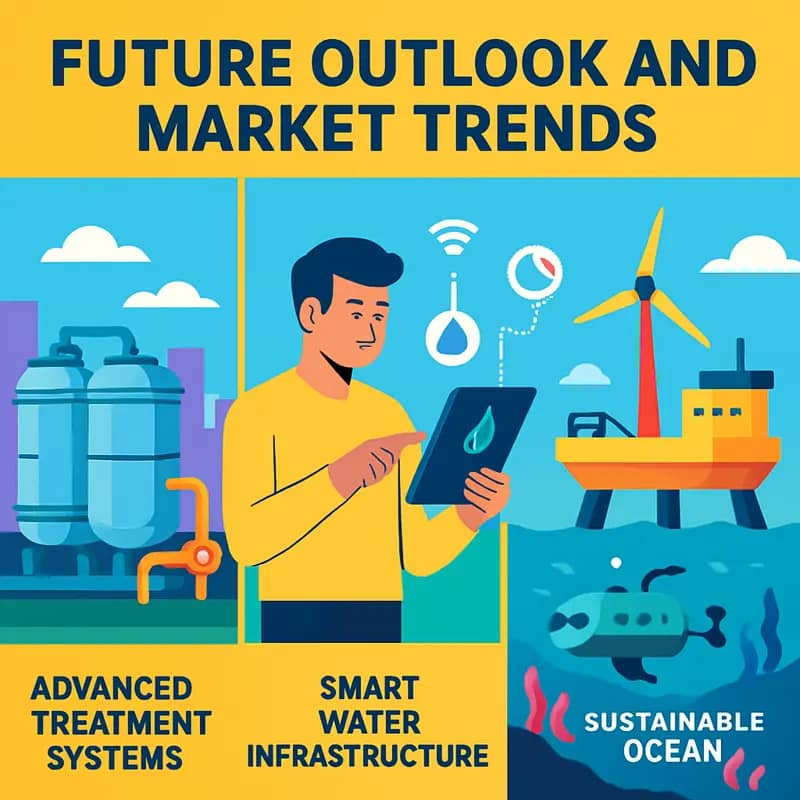
As water scarcity and climate pressures intensify, Blue Coast’s investment vision centers on scaling breakthrough technologies that can fundamentally transform water management. Drawing from our analysis of emerging opportunities, several key trends are shaping the firm’s forward-looking strategy.
Digital transformation stands as a primary focus area, with artificial intelligence and advanced analytics enabling predictive maintenance, optimization of treatment processes, and more efficient resource allocation. The convergence of hardware innovations with smart software platforms creates opportunities to dramatically improve infrastructure performance while reducing operational costs.
Circular economy solutions represent another critical frontier. Technologies that enable water reuse, resource recovery, and waste valorization are gaining traction as utilities and industries seek to maximize the value extracted from every drop. Blue Coast sees particular promise in innovations that can transform wastewater treatment from an energy-intensive liability into a revenue-generating asset through the recovery of valuable materials and production of renewable energy.
Nature-based solutions and green infrastructure are also moving to the forefront as cities grapple with climate resilience. Investment opportunities exist in both engineered natural systems and hybrid approaches that combine conventional infrastructure with ecological solutions. The key is identifying scalable technologies that can deliver measurable performance while providing broader environmental benefits.
However, significant challenges remain in accelerating adoption of new water technologies. Risk-averse utilities, complex regulatory frameworks, and long sales cycles continue to pose barriers. Blue Coast is addressing these through innovative financing models, strategic partnerships with established industry players, and intensive support for portfolio companies in areas like pilot projects and regulatory compliance.
Looking ahead, Blue Coast envisions playing a catalytic role in bringing transformative water solutions to scale. This includes expanding investment in early-stage companies with breakthrough potential, while also supporting the growth of proven technologies ready for widespread deployment. The firm’s thesis centers on backing passionate entrepreneurs who combine technical excellence with practical understanding of market needs and implementation realities.
Ultimately, Blue Coast sees tremendous opportunity in the convergence of sustainability imperatives, technological capabilities, and market demand for innovative water solutions. By maintaining a long-term perspective while being responsive to evolving needs, the firm aims to generate both strong returns and meaningful impact in addressing global water challenges.
Nature’s Engineers: The Blue Coast Approach

At the intersection of nature and engineering lies Blue Coast’s revolutionary methodology for coastal infrastructure development. Drawing inspiration from marine ecosystems, the company has pioneered an approach that harnesses biological systems’ inherent resilience while incorporating cutting-edge engineering principles.
The foundation of this methodology rests on biomimetic design – carefully studying and replicating nature’s time-tested solutions. Rather than fighting against natural coastal processes with rigid concrete barriers, Blue Coast develops dynamic systems that flex and adapt like natural reefs and wetlands. These living infrastructure solutions actually strengthen over time as marine organisms colonize and reinforce the structures.
A key innovation in this approach is the development of bio-enhanced materials that facilitate the growth of calcium-secreting organisms. When strategically placed, these materials form the scaffolding for nature to build its own coastal protection systems. The resulting structures not only buffer wave energy but also create thriving marine habitats that support biodiversity and enhance water quality.
Complementing the biological elements, advanced computational modeling allows Blue Coast to optimize the placement and design of these hybrid systems. By simulating decades of wave patterns, storm events, and ecosystem development, engineers can predict and enhance the long-term performance of each installation. This marriage of biological understanding and engineering precision ensures solutions that are both environmentally sustainable and structurally sound.
Perhaps most remarkably, these bio-engineered systems demonstrate an ability to self-repair and strengthen naturally over time – a sharp contrast to traditional infrastructure that degrades and requires constant maintenance. As climate change brings rising seas and more intense storms, this capacity for autonomous adaptation becomes increasingly crucial.
The scalability of this approach is particularly noteworthy. While each coastal environment presents unique challenges, the fundamental principles of working with natural processes remain consistent. This allows Blue Coast to rapidly adapt and deploy solutions across diverse geographic contexts while maintaining the core biomimetic approach that defines their methodology.
As evidenced in recent case studies of nature-based coastal protection, this fusion of biological wisdom and engineering innovation is proving more cost-effective and resilient than conventional approaches. The implications extend beyond immediate coastal protection to impact marine ecosystem health, carbon sequestration, and community resilience.
The Investment Landscape: Why Water Tech Matters
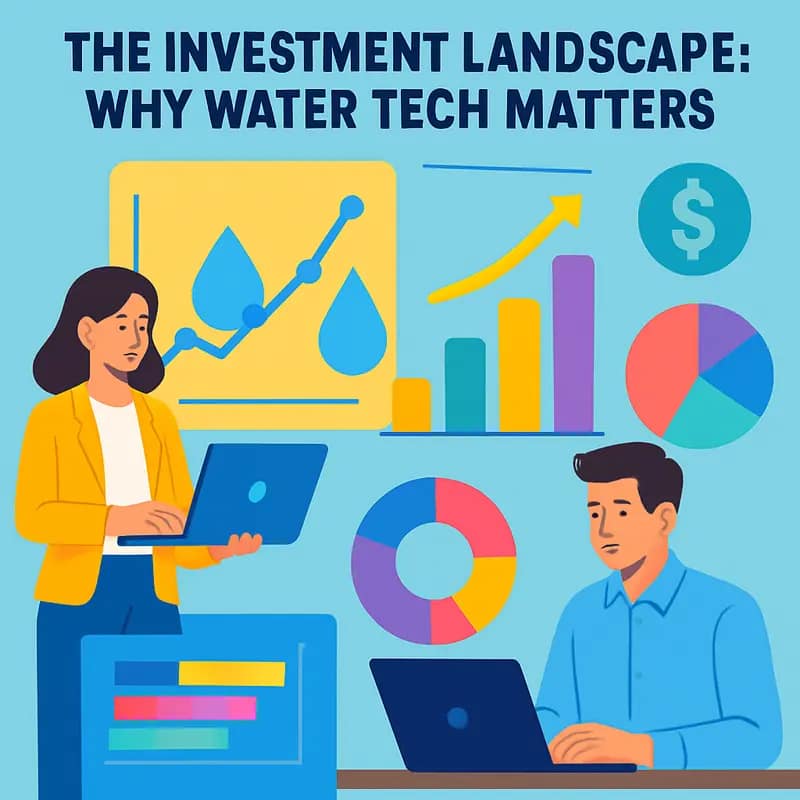
Coastal water management technologies represent one of the most promising frontiers in climate adaptation investment. The convergence of rising sea levels, increasing storm intensity, and growing coastal populations has created unprecedented demand for innovative water management solutions. This demand translates into a market projected to reach $200 billion by 2030.
The opportunity landscape splits into three key segments: infrastructure protection, water quality management, and ecological restoration. Traditional “gray” infrastructure approaches like seawalls and breakwaters are giving way to hybrid solutions that combine engineered elements with natural systems. These integrated approaches often deliver superior performance at lower lifetime costs while providing valuable ecosystem services.
Investors are particularly drawn to scalable technologies that address multiple challenges simultaneously. For example, living shoreline solutions that combine wave attenuation with water filtration and habitat creation can deliver both immediate cost savings and long-term ecological benefits. This multi-benefit approach helps de-risk investments while maximizing potential returns.
Regulatory tailwinds are also accelerating market growth. Governments worldwide are implementing stricter coastal protection requirements and increasing funding for resilience projects. The U.S. Infrastructure Investment and Jobs Act alone allocated over $50 billion for coastal and climate resilience. Similar initiatives are emerging globally, creating a robust project pipeline for proven technologies.
However, the investment landscape isn’t without challenges. Long sales cycles in public infrastructure projects, complex permitting requirements, and the need for extensive pilot testing can extend commercialization timelines. Successful investors typically take a portfolio approach, balancing near-term revenue opportunities in private markets with longer-term public sector plays.
The most promising investment opportunities lie in technologies that can demonstrate clear cost advantages, measurable environmental benefits, and the ability to scale across different geographic contexts. Advanced monitoring systems, nature-based engineering solutions, and predictive maintenance platforms are attracting particular interest from venture capital and private equity firms.
Critically, the sector’s growth potential extends beyond direct technology plays. Supporting services like environmental monitoring, project design, and maintenance create additional investment opportunities throughout the value chain. This ecosystem approach allows investors to capture value across multiple stages of coastal resilience projects.
As climate impacts intensify, coastal water management technologies will become increasingly central to global adaptation strategies. For investors who understand the technical requirements and market dynamics, this sector offers compelling opportunities to generate both financial returns and positive environmental impact.
Impact Metrics: Measuring Success Beyond ROI
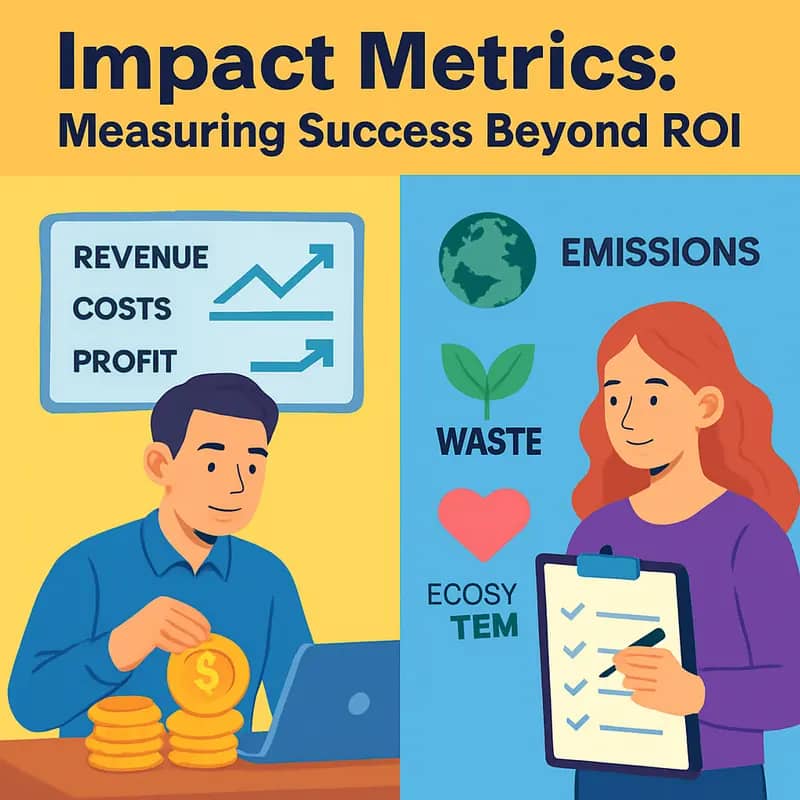
Blue Coast has redefined success metrics in water technology investment by developing a comprehensive framework that measures both financial returns and broader impact outcomes. This dual-lens approach allows the firm to quantify its contributions to environmental sustainability and social progress while maintaining strong business performance.
At the core of Blue Coast’s impact measurement system lies a sophisticated set of key performance indicators (KPIs) that track three critical dimensions: water conservation, ecosystem health, and community resilience. For water conservation, the firm monitors cubic meters saved through implemented technologies, improvements in water use efficiency, and reductions in water waste. Ecosystem metrics encompass changes in water quality parameters, habitat preservation metrics, and biodiversity indicators in affected water bodies.
The social impact dimension proves particularly innovative, incorporating metrics around improved water access, public health outcomes, and job creation in water-related sectors. Blue Coast leverages innovative approaches to measure these complex social dynamics in water reuse projects, ensuring communities benefit tangibly from their investments.
What sets Blue Coast’s framework apart is its integration of these metrics into investment decision-making. Rather than treating impact measurement as a post-investment reporting exercise, the firm incorporates projected impact metrics into its due diligence process. This approach helps identify technologies and projects that maximize both financial returns and positive environmental and social outcomes.
The framework also includes accountability mechanisms through third-party verification and regular impact audits. Blue Coast requires portfolio companies to report quarterly on their impact metrics, with annual comprehensive assessments conducted by independent evaluators. This rigorous approach ensures transparency and credibility in impact reporting.
Data analytics plays a crucial role in converting raw impact data into actionable insights. Blue Coast employs advanced modeling techniques to understand the relationships between various impact metrics and financial performance. This analysis helps optimize investment strategies and demonstrates how positive environmental and social outcomes can drive long-term value creation.
The firm’s impact measurement framework has become a model for the industry, demonstrating how investors can rigorously track and verify their contributions to sustainability goals while maintaining robust financial performance. This approach has proven particularly valuable in attracting institutional investors who increasingly demand both competitive returns and measurable impact outcomes.
Scaling Solutions: The Path Forward

Blue Coast’s strategic vision for scaling its water technology solutions rests on three interconnected pillars: technology optimization, strategic partnerships, and impact investment. By carefully orchestrating these elements, the company aims to amplify its positive impact on water sustainability while ensuring sustainable growth.
The technology optimization pathway focuses on making Blue Coast’s solutions more adaptable and modular. Rather than pursuing a one-size-fits-all approach, the company is developing flexible platforms that can be customized for different contexts and scales. This adaptability enables faster deployment across diverse geographic and regulatory environments while maintaining consistent performance standards.
Strategic partnerships form the second critical pillar of Blue Coast’s scaling strategy. The company is forging alliances with utilities, industrial players, and regional water authorities to create implementation frameworks that can be replicated across similar use cases. These partnerships provide valuable proof points while establishing the operational protocols needed for wider adoption.
The role of impact investment cannot be overstated in Blue Coast’s expansion plans. The company has structured its funding approach to align with both financial returns and measurable environmental impact. This dual-return model has attracted a diverse pool of investors, from traditional venture capital to environmental, social and governance (ESG) focused funds. The influx of strategic capital enables Blue Coast to invest in enhanced manufacturing capabilities, strengthen its implementation teams, and expand its geographic presence.
Crucially, Blue Coast recognizes that scaling is not just about growing bigger – it’s about growing smarter. The company has implemented a phased expansion strategy that prioritizes markets where its solutions can deliver the maximum environmental impact. This targeted approach helps optimize resource allocation while building a strong track record of successful implementations.
Looking ahead, Blue Coast is positioning itself to capitalize on the growing convergence between water technology innovation and climate resilience. The company’s scaling roadmap includes developing new financing mechanisms that can help accelerate adoption, particularly in regions where traditional funding models may be insufficient.
Ultimately, Blue Coast’s path forward represents a carefully calibrated balance between ambitious growth targets and sustainable implementation. By leveraging impact investment to scale proven solutions, the company aims to transform the water technology landscape while generating lasting environmental and social benefits.
Final words
Blue Coast’s journey in water technology investment represents a masterful blend of financial acumen and environmental stewardship. Their strategic approach to portfolio building, coupled with a deep understanding of water sector dynamics, has positioned them as a pivotal force in advancing sustainable water solutions. The firm’s commitment to backing innovative entrepreneurs and technologies demonstrates their recognition that the future of water management requires both cutting-edge solutions and sustainable practices. As global water challenges continue to evolve, Blue Coast’s investment strategy provides a compelling blueprint for others in the sector. Their success in balancing profitable investments with positive environmental impact showcases how strategic capital deployment can drive both financial returns and sustainable development. For water entrepreneurs and impact investors alike, Blue Coast’s model offers valuable lessons in how to navigate the complex landscape of water technology investment while maintaining a clear focus on long-term sustainability and innovation.
Wanna explore the Full List of Water Investors that cut at least two checks over the past decade? Check it out and bookmark it, I update it regularly!
Learn more: https://dww.show/the-ultimate-water-investor-database/
About us
Through my “(don’t) Waste Water” platform, I offer unique and insightful coverage of the water industry that combines technical expertise with engaging storytelling. If you haven’t yet, it might be time for you to subscribe to the podcast, the youtube channel and/or the newsletter!
